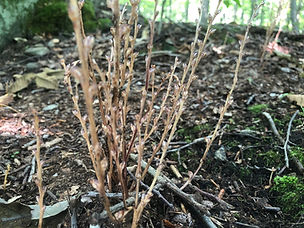Let the Beech Drop

By Sam Nunes, Environmental Educator
What color comes to mind when you read the word “Plant”? GREEN! The green color found in many plants comes from an organelle in the plant cell called chloroplast that contains chlorophyll. This is used to convert sun energy into sugar through photosynthesis. Plants look green because that color is not used for photosynthesis and is reflected back into our eyes. But what happens when a plant does not have chlorophyll?
In New England it is common to find beech trees scattered throughout our forests. They are known for their smooth bark that people love to carve into – side note DON’T DO THAT. Beech trees have chlorophyll in their leaves and can photosynthesize. In the fall if you look down on the ground under their canopy you’ll find a small plant that is not green at all. It’s called a beechdrop.
Beech drops are considered parasitic plants. Parasitic plants steal their nutrients from other organisms, in this case the beech tree. They use a haustorium, similar to a root, to tap into the beech tree roots and feed off its stored nutrients. Because of this they do not need chlorophyll therefore they are not green. In fact they are more of a beige color with very small purple flowers. Don’t worry, these plants are annuals, so they are only around for a few months and are small enough to not impact the health of the tree.
Something very beautiful about beechdrops is their ability to clue us into what the world looks like beneath our feet. Beech trees have very shallow roots, which can be seen easily around the stem, but beechdrops can reveal just how far those roots spread. When you notice them on your next forest walk, take a look around and see if you can map out the roots!
Sources:
-
Holland, Mary. Naturally Curious. North Pomfret: Trafalgar Square Books, 2010.





